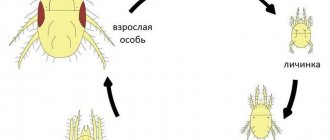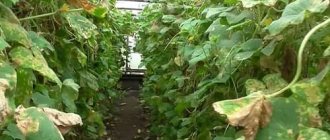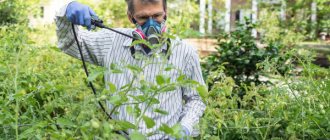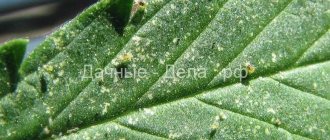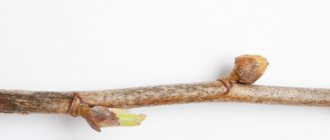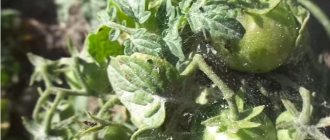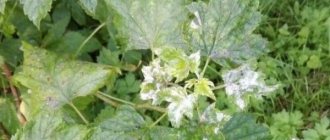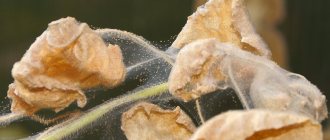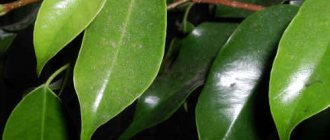Plants are weakening, withering away, but you can’t understand what’s wrong? There are probably spider mites in your area, and you have a serious fight ahead of you. How to identify an uninvited guest and get rid of him in the garden, greenhouse, garden and indoor plants?
To begin with, spider mites need to be detected, and without knowledge about them this is not so easy. Adult representatives of this species reach only 1 mm in length, which means that not everyone can see them. And yet, to be fully armed, you need to know what a spider mite looks like and what traces it leaves on different crops.
The spider mite is not an insect, but an arachnid, i.e. animal. Therefore, insect repellents are not suitable for controlling spider mites and are a waste of time and money.
What is a spider mite?
Spider mites are one of the dangerous pests, tiny in size, but causing damage to many types of plants by sucking the juice from the leaves. It is not so easy to detect it at the initial stage of infection, but you can recognize it by knowing what it looks like and what traces it leaves.
It harms trees, flowers, garden crops, indoor plants and those crops that grow in greenhouses.
Traces of the pest's activity can be seen on the leaves; thin cobwebs and light dots and puncture sites appear on the upper side; small red parasites can be seen on the lower side.
Spider mites on plants.
Appearance and structure of the parasite
The mite belongs to the arachnid family, the female is slightly larger than the male, the body is ellipsoidal, convex on top, flat on the bottom. The length of the female is 0.4-0.5 mm, the male is 0.3-0.4 mm. The larvae are small, transparent, light green or brown in color with two large dark spots on the sides. Females are orange-red or red, adult parasites have 4 pairs of legs, and larvae have 3 pairs.
Life cycle
Life cycle.
The female lays eggs, from which faces appear after 3 days. After several molts, having gone through two stages of nymphs, they turn into adults.
Under favorable conditions, from the appearance of larvae to imago takes from 5 to 20 days. Females live 2-4 weeks and during this time they are able to lay hundreds of eggs. During the season, 4-5 generations of ticks appear. For the winter, females hide in the upper layers of the soil or in cracks in the trunks and live there until spring.
Mites develop especially quickly in dry and hot weather and on plants overfed with nitrogen fertilizers.
Where can I meet
Pests can be found everywhere where there is any vegetation. Spider mites live in all regions except Antarctica.
Means of struggle
For pest control, it is preferable to use special anti-tick preparations - acaricides . Before use, you need to study the instructions - whether the product can be used together with other drugs or not, whether it is suitable for treating plants indoors or only outdoors.
No matter how effective the drug is, eggs and larvae cannot be completely destroyed in one procedure. To stop their reproduction, 2-4 treatments will be required .
The first spraying kills 70–80% of active adults, leaving larvae and nymphs behind. They are targeted for a second treatment after 5–6 days. After the same period, the following control sprayings are carried out.
All treatments are effective only on dry leaves, the best time is the morning until noon at an optimal air temperature of 20-25°C.
Spider mites adapt to chemicals, so they need to be changed. Spraying indoor flowers with preparations alternates with a hot shower. If you wash the leaves in the shower regularly - once every 2-3 weeks - then you will need chemicals less often . The use of green, laundry soap or shampoo will enhance the effect. Soap foam is applied to the leaves for 5 minutes, then washed off with hot water.
This method is not suitable for indoor plants with pubescent leaves that cannot be washed, otherwise rotting will begin, as well as large plants in large pots and tubs.
Chemical and biological drugs
Apollo
Pome and stone fruit crops are sprayed during the formation of buds before they turn pink. The grapes are harvested for the first time during the period of swelling and bud opening, and again during the budding period. To prepare a solution, 4 ml of the drug is diluted in 10 liters of water.
Akarin
This powerful insectoacaricide is often called “first aid” in pest control. It can be used in hot weather. The effect is reduced when used in foggy and rainy weather. Please note that the product is dangerous for bees.
The dosage of the anti-tick drug is 2 ml per 1 liter of water. For stickiness, add 1 tbsp. a spoonful of liquid soap or washing powder in a bucket of water.
Fitoverm
To spray fruit trees during the growing season, prepare a solution with a concentration of 0.15% (1.5 ml of the drug per 1 liter of water). A young tree will require 2–4 liters, an adult tree – 5–8 liters.
For berry bushes, 2 ml are diluted in 1 liter of water. This volume is spent on one large bush. To spray vegetables, dissolve 1 ml of product in 1 liter of water. The break between treatments is 20 days.
For indoor and garden flowers, the dosage of the drug is 2 ml per 1 liter of water. Houseplants are treated at intervals of 14 days, in open ground more often - once a week.
Vermitek
Biological non-toxic insectoacaricide, it does not leave stains or burns on the leaves. Used for prevention and at the first sign of a pest. When spraying, completely wet the leaves, avoiding dripping. Consumption rates for the product are 2.5–3 ml per 10 liters of water.
Traditional methods
If there are few pests, use herbal decoctions and infusions.
- 1 kg of dry chamomile (leaves and flowers) is poured into 10 liters of hot water and left for 12 hours. The infusion is filtered and diluted with water in a ratio of 1:3. Then add laundry soap and spray it on vegetable and flower crops, trees and berry bushes.
- Half a bucket is filled with onion peels and finely chopped onions, then 10 liters of hot water are poured. Leave for 24 hours, filter and dilute with water 1:2 before use.
- The horseradish leaves along with the petioles are crushed, the bucket is filled 2/3 and water is added to the brim. Instead of leaves, you can take crushed horseradish roots. In this case, 2 times less raw materials will be required. The mixture is infused for 1 hour.
- 1 kg of tansy stems along with plant flowers are poured into 10 liters of water and brought to a boil. The broth is cooled and filtered before use.
- The pest is successfully destroyed by solutions of medications. For ticks, plants are sprayed with a solution of hydrogen peroxide – 2 tbsp – once a week. l per 1 liter of water.
- Ammonia (ammonia) not only removes pests, but also serves as a nitrogen fertilizer. 30 ml of ammonia is dissolved in 10 liters. water.
- Plants are protected by joint plantings with crops that are not afraid of spider mites. Onions, garlic, mustard, basil, parsley, and calendula repel the pest.
Signs of spider mites appearing on an apple tree
At the initial stage of infection of an apple tree with spider mites, it is not so easy to detect. The larvae of this parasite are very small, and light yellow dots, puncture sites, remain on the top of the leaves. Over time, the spots on the leaves become wider, and a thin cobweb appears on them, they dry out and fall off. Ticks are very prolific and there are more and more of them over time. It is important to detect parasites in time and begin to fight them.
Types of mites on plants.
How to find out about plant infestation
The first sign of a tick appearance is light spots on the leaves remaining at the puncture site.
Gradually there are more and more of them, the dots merge into large whitish or reddish spots. The leaves take on an ugly shape, dry out and fall off. At this time, you can notice thin threads entangling the leaves and stems of plants. With severe lesions, the amount of cobwebs increases.
Spider mites prefer juicy young greens rich in chlorophyll. In spring, pests appear on weeds: quinoa, plantain, coltsfoot, and nettle.
Gradually, mites move to cultivated plants: flowers, fruit trees and shrubs, berry fields. You can notice their presence in mid-summer: at this time the colony of pests increases significantly.
The following plants are especially affected by spider mites:
- garden strawberries;
- gooseberry;
- currant;
- raspberries;
- apple trees;
- pears;
- tomatoes;
- cucumbers;
- melons;
- eggplant;
- pepper;
- beans.
Pests often attack flower beds and balcony boxes. They can be seen on asters, roses, marigolds, saffron, and petunias. Mites enter the house with cut flowers and pose a danger to all indoor plants.
Technology for treating trees against pests
For preventive purposes, or when ticks appear, the garden is treated from spring to autumn. Correct and timely spraying will lead to good results. For each time, appropriate chemicals are selected.
- When treating trees with chemicals, it is important to take precautions. Use personal protective equipment, avoid contact with skin and eyes of toxic agents.
- Spraying should be carried out in dry, windless weather.
- Spray the product from the bottom up, since mites are located mainly on the lower part of the leaves.
- Treatments should be carried out in the morning or evening.
- Children and animals are strictly prohibited from being in the garden while working.
- After treatment, wash your face and hands with soap.
When to treat
It is important to observe the timing of tree processing; the amount of harvest and the resistance of crops to pest attack depend on them.
Before flowering
The first treatment after winter is carried out before the buds open, during which overwintered mites and other pests die. As soon as the temperature rises to +5 degrees and above, the trees and the soil around them are treated with copper or iron sulfate.
The second treatment is done after the leaves bloom, but before flowering. Use any insecticides or acaricides available to gardeners.
After flowering
Trees can be sprayed with chemicals only after fruit has set. For treatment, choose other insecticides or acaricides that have not yet been used in the current season. If you spray several times in a row with the same product, the ticks will get used to it.
During fruiting
Treatments should be stopped a month before harvesting the fruits. But as a last resort, in the event of a massive pest invasion, if treatment is required, use preparations that quickly decompose and do not remain on the fruit.
After harvest
After harvesting, but before the leaves fall, they are treated with copper sulfate, urea or any insecticides. Ticks remaining for the winter die.
How often should trees be treated?
During the growing season, trees are treated in the spring, before the leaves appear, after the leaves bloom, after the ovaries form, after harvesting.
But in extreme cases, when trees are damaged by pests, treatments are carried out more often, because the mite is capable of producing 4-5 generations in a season and causing great harm.
You can use two control methods simultaneously for greater effectiveness.
Processing times in different climate zones
Treatments of trees in the garden in different climatic zones are carried out taking into account weather conditions. In the southern regions of the country, work in the garden begins early; in cooler regions, the dates are shifted. You need to focus on the onset of warm weather in spring and the blossoming of leaves, flowering and harvesting of fruits.
Ticks on an apple tree.
Preventive measures
Preventative treatments in the garden give good results, many diseases and pests are destroyed, and the resistance of apple trees increases. Work in the garden begins in spring and continues until late autumn. Prevention measures include:
- spring tree pruning and spraying;
- feeding;
- treatment before and after flowering;
- cleaning leaves and trimming damaged branches;
- cleaning the trunk and whitewashing;
- autumn cleaning and digging of the trunk circle.
Apple tree varieties resistant to spider mites
Apple tree varieties that are completely resistant to mite damage have not yet been developed by breeders. Some varieties have good immunity and are less susceptible to attack by pests. But the sustainability of crops can be increased if good care is provided: timely preventive treatments, fertilizing, watering, pruning and winter protection.
Previous
MitesRed mite on orchids: how to protect indoor flowers from the most dangerous pest
Next
MitesRed mites on indoor plants: how to protect your favorite flowers from the pest
Prevention
To prevent tick infestation in your home:
- Each new plant purchased must be quarantined for 2 weeks. After this, making sure that there are no parasites on it, the plant is placed next to the others.
- All purchased soil, like any street soil, must be disinfected before use. The easiest way: bake in the oven at 90 degrees for half an hour.
- Since ticks do not like high humidity, the moisture level must be constantly maintained. To do this, you can regularly spray the plants in your apartment with a spray bottle.
- You also need to constantly maintain cleanliness, do not accumulate dust on the windowsills or on the leaves of plants.
To prevent mite infection in a greenhouse or in open ground, you can plant dill next to the seedlings. It will attract beneficial insects and repel spider mites with its aroma.
Fighting ticks is not so easy; it is much easier to arrange preventive measures and treatment with drugs. But even in fairly advanced cases, using the full range of remedies in a timely manner, you can save and cure at least the remainder of the harvest in the garden and garden, as well as your favorite flowers in the apartment.
